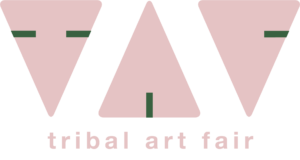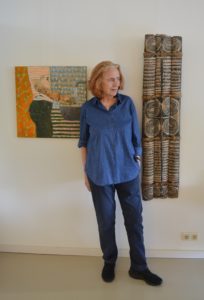Ruscha Langelaan
I don’t feel like a collector at all, but then one day you somehow have a lot of objects!
Ruscha Langelaan is a painter, her apartment is stylishly furnished. She loves hanging objects on the wall, alongside a number of her own paintings, her walls are adorned with tribal art: kissi pennies – traditional money from Sierra Leone, a staff from Ethiopia and an Asmat sculpture. In addition, she has a display cabinet containing a number of smaller objects. Tjuringas from Australia can be found on a bookcase in the middle of the room.
Ruscha actually came into contact with tribal arts by chance. About twenty years ago, she was cycling over the Spiegelgracht when she met fellow artist Ronald Noorman. He was about to visit a gallery showing tribal art and asked if she would like to join him. She was immediately impressed, but she was also convinced that she couldn’t afford it and it was way too expensive for her. When she saw her colleague Ronald buying objects, Ruscha thought: if he can do that, so can I. Her first purchase was a Wunda shield from Australia. In the years that followed, she often turned to Ronald for advice about purchases.
She once read somewhere that you should never buy everything from one dealer, so she visits various galleries. She also looks at online auction houses, such as Christie’s and Sotheby’s, and marvels at the extortionate items that are auctioned there.
At the moment, her good friend Gerard van den Heuvel is her main adviser. He knows a great deal about tribal arts. He was guest curator for two exhibitions in the Afrika Museum in Berg-en-Dal and worked on the important Ubangi project there. Recently, he helped Ruscha with the purchase of an Arawe shield from New Britain. She had seen it online on the Lempertz auction site in Brussels and fell in love with it immediately. He not only gave her more information about these shields, but also advised her about how to bid. It was really exciting because it’s not something she does very often. Ruscha keeps a folder containing information about the use and origin of each of the objects she purchases and the invoice. Information about the origin and authenticity of an object is very important to her. She is very pleased that she has all the information in one place, because it provides a good overview of the objects she’s bought over the years.
Each year, she tries to visit the Parcours des Mondes in Paris. She used to enjoy going there with her husband Ed de Moor and whenever they went inside a gallery together, people would assume that he was the collector. He would then steer them towards Ruscha with the words “ma femme, ma femme”. She finds it strange that this world is still very much a man’s world.
She’s never really looking for objects, but is sometimes overwhelmed by something she comes across. “Suddenly you really want to have it, then something funny happens to you.” She recently bought a Boiken sculpture from Papua New Guinea, which she saw on the website of a dealer from the United States and she was surprised that it was suddenly for sale. In order to get her hands on it, she had to act quickly and wasn’t able to deliberate. She’s still thrilled with this quick purchase, especially considering she never usually buys anything impulsively; she always makes well-considered purchases. She doesn’t struggle with the enormous greed that some collectors have either. She doesn’t feel like a collector at all, “but then one day you somehow have a lot of objects!”
Whenever the Tribal Art Fair is on, she always visits a few times, and she really enjoys attending the readings. Her advice to new collectors is to look a lot, but above all to talk about the objects. There’s so much that it’s difficult to know where to begin. And talking about it is both fun and educational.
Ruscha Langelaan
Ik voel mij helemaal geen verzamelaar maar op een gegeven moment heb je ergens veel van.
Ruscha Langelaan is schilder, ze woont in een stijlvol ingericht appartement. Ze houdt ervan om objecten aan de muur te hangen dus aan de muur hangt, naast een aantal van haar schilderijen, ook etnografica: kissi pennies -traditioneel geld uit Sierra Leone, een staf uit Ethiopië en een Asmat-sculptuur. Daarnaast heeft ze een vitrine met een aantal kleinere objecten en midden in de kamer staan op een boekenkastje en aantal tjuringa’s uit Australië.
Ruscha kwam eigenlijk toevallig met etnografica in aanraking. Zo’n twintig jaar geleden fietste zij over de Spiegelgracht en kwam collega-kunstenaar Ronald Noorman tegen. Hij stond op het punt om een galerie met etnografica binnen te gaan en vroeg haar mee. Ze was direct onder de indruk, maar ze was ook overtuigd dat ze dit niet kon betalen en veel te duur voor haar was. Toen ze zag dat haar collega Ronald wel objecten kocht, dacht Ruscha: als hij dat kan, kan ik het ook. Haar eerste aankoop was een Wunda-schild uit Australië. Vervolgens vroeg ze Ronald vaak advies bij aankopen.
Omdat ze ooit ergens gelezen heeft dat je nooit alleen bij één handelaar moet kopen, bezoekt ze verschillende galeries. Ook kijkt ze op internet bij veilingen van bijv. Christie’s en Sotheby’s en verbaast zich dan over de peperdure dingen die daar worden geveild.
Momenteel is goede vriend Gerard van den Heuvel haar belangrijkste adviseur. Hij
weet echt heel veel van etnografica. Hij was gastconservator voor twee tentoonstellingen in het Afrika Museum in Berg en Dal en hij werkte mee aan het belangrijke Ubangi-project in dat museum. Onlangs hielp hij Ruscha nog bij de aankoop van een Arawe-schild uit Nieuw-Brittannië. Ze had het gezien op internet bij Lempertz in Brussel en vond het meteen prachtig. Behalve dat hij haar meer informatie kon geven over deze schilden, adviseerde hij ook hoe ze het beste kon bieden. Heel spannend omdat ze dit niet vaak doet. Van al haar aankopen houdt Ruscha een map bij met daarin informatie over het gebruik en de herkomst van de objecten en de rekening. De kennis over herkomst en authenticiteit van een object vindt ze heel belangrijk. Ze is heel blij dat ze alle informatie bij elkaar heeft, omdat het een goed overzicht geeft van de objecten die ze in de loop der jaren gekocht heeft.
Ze probeert elk jaar de Parcours des Mondes in Parijs te bezoeken. Vroeger kwam ze daar ook graag met haar echtgenoot Ed de Moor en wanneer ze samen een galerie binnenkwamen, dan ging men er meestal van uit dat hij de verzamelaar was. Hij stuurde ze dan met de woorden “ma femme, ma femme” direct door naar Ruscha. Ze vindt het raar dat deze wereld eigenlijk nog steeds een mannenwereld is.
Eigenlijk is ze nooit echt op zoek naar objecten, maar wordt overvallen door iets wat ze tegenkomt. “Opeens wil je het dan heel graag hebben, dan gebeurt er iets raars met je”. Zo kocht ze onlangs uit Papoea-Nieuw-Guinea een Boiken-beeld dat ze zag op de website van een handelaar uit de Verenigde Staten en ze was verbaasd dat het opeens te koop was. Om het te krijgen moest ze in dit ze geval snel handelen en kon ze niet overleggen. Ze is nog altijd heel blij met deze snelle aankoop. En dat terwijl ze normaal gesproken bijna nooit iets impulsief koopt, ze koopt eigenlijk altijd weloverwogen. Ze heeft ook geen last van die enorme hebberigheid die sommige verzamelaars hebben. Ze voelt zich ook niet echt een verzamelaar “maar op een gegeven moment heb je ergens veel van”.
Als de Tribal Art Fair is, gaat ze daar altijd wel een paar keer heen, en ze woont ook met veel plezier de lezingen bij. Haar advies aan beginnende verzamelaars is om veel te kijken maar vooral ook te praten over de objecten. Er is namelijk zoveel, dat het moeilijk is om te weten waar je moet beginnen. Er over praten is leuk en leerzaam.

